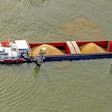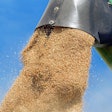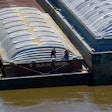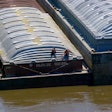
At the National Grain and Feed Association (NGFA) Annual Convention, Joseph Hinrichs, president and CEO of CSX, highlighted the need for enhanced safety measures and industry-wide collaboration in the rail sector.
In his general session, “Current Operations and Recent Advancements at CSX,” Hinrichs said that rail safety must be a shared responsibility among all Class I railroads. Hinrichs pointed to Norfolk Southern’ s high-profile derailment incident in East Palestine, Ohio, as a reminder of the far-reaching consequences of rail accidents.
While these incidents directly impact the railroad involved, the fall-out extends industry-wide, leading to higher insurance costs, increased regulatory scrutiny and the erosion of public trust in the railroads.
“The reality is, when something goes wrong in one part of the industry, we all pay the price,” Hinrichs said. “That’s why safety can’t be treated as a competitive advantage — it has to be a collective effort.”
CSX took the first step toward this goal by sharing its safety algorithms and threshold data with other railroads after the incident.
“We put our safety processes out there for the industry to see, because there’s no reason for every railroad to have its own separate system for tracking safety risks,” Hinrichs said.
However, he also noted that regulatory hurdles have slowed technological advancements in rail safety.
“For the last four years, we’ve made no progress in technology because the FRA (Federal Railroad Administration) has been preventing us from making the changes we need,” Hinrichs said.
He said that regulators and the industry must work together to ensure new safety innovations — such as automated inspections and AI-driven decision-making — can be implemented effectively.
Increasing technology's role in rail
Hinrichs pointed to automation and AI as critical tools for improving safety and operational efficiency. He argued in favor of automated rail inspections, particularly in extreme conditions like Chicago’s harsh winters, where manual inspections remain the norm.
“There’s no reason why we should still be doing manual inspections when we have technology that’s more accurate, more consistent and doesn’t call in sick,” Hinrichs said.
He also underscored the importance of real-time railcar tracking, noting that while it's hard to believe in our technology-driven world, most railroads still don’t know where their railcars are located.
CSX has started placing GPS tracking on thousands of railcars, part of an industry-wide initiative that he sees as essential for both safety and efficiency.
Calling on railroads to collaborate
In addition to safety improvements, Hinrichs urged Class I railroads to shift from a competitive to a cooperative mindset — particularly when it comes to interchanges and operational coordination.
He said since joining the rail industry five years ago, he’s questioned the longstanding rivalry among major rail carriers, noting that CSX frequently works with the Union Pacific, BNSF, and CPKC railroads to move freight. However, more can be done. The historically fragmented approach to interchange operations has led to inefficiencies, and has pushed businesses toward trucking.
“We keep talking about ‘taking trucks off the road,’ but the data shows we haven’t done that,” Hinrichs said. “For 20 years, we’ve chased business away instead of investing in better service. If we actually worked together instead of fighting over who gets the longer haul, we could grow the entire pie.”
Despite rail's challenges, Hinrichs remains optimistic about the future, if the rail industry can embrace transparency, technology and collaboration.
“Rail has lower costs than trucking and it’s five times better for the environment," he said. "If the railroads run better, everyone wins. Our customers win. The economy wins. Society wins.”
The call for a more unified, technology-driven and customer-focused rail industry continues to drive CSX forward, as well as Hinrichs’ hope that Class I railroads will recognize the mutual benefits of collaboration.


















